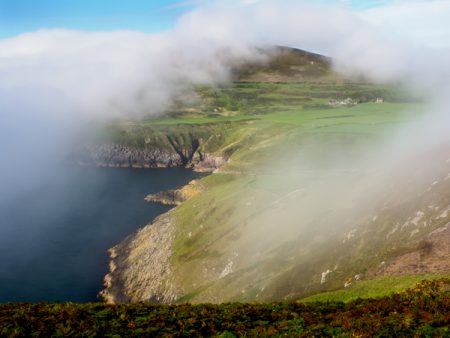
Well, we’ve had some interesting weather recently, haven’t we? Much as I love blue skies, white clouds and clear air, the photographer can find those conditions a bit predictable. That all changed last week when hot and humid conditions moved up from the Continent, even here in Wales.
It so happened that Jane and I had planned our first few days away together for many months, eventually plumping for Aberdaron, at the tip of the Lleyn peninsula (Penllyn) in north Wales. From the house here on a clear day we can see a line of hill-tops – “the oylands” as a brummie once described them – extending out across Cardigan Bay and culminating in Bardsey Island ( Enlli ), the only actual island of the lot. But by the time you reach Aberdaron, there is such a different feel to the landscape that it could almost be an island. It is so far down the ever-narrowing peninsula that it is – in effect – in the middle of the Irish Sea. And it has the weather to prove it.

The journey was hot with intermittent low cloud and fog. We arrived at Mynydd Mawr, at the end of Penllyn beyond Aberdaron, just in time to see Enlli, draped in fog, through a gap in the cloud. It looked amazing. But within thirty seconds sea fog engulfed the landscape and this wonderful vision disappeared, remaining that way for the next few hours. The fog layer had no great depth, but at 160m altitude we weren’t quite high enough to escape it. It began to get rather frustrating. I phoned Ben Porter, a friend who lives nearby, and he said he was on Mynydd Rhiw, a few miles inland and it was amazing! I should get up there asap! I drove slowly along single-track, hedge-rimmed lanes towards Rhiw in poor visibility; it felt like we were fighting a losing battle against the onset of dusk.
However we arrived on Mynydd Rhiw just before the sun set over the Irish Sea. We were just above the cloud and a brocken spectre was just visible at the anti-solar point. Other hilltops further inland stood out, from Carn Fadryn and Yr Eifl on the peninsula, round to the great peaks of Eryri. But they were all fading fast as the cloud layer rose steadily at every point of the compass. It seemed like a case of “you should have been here earlier” for the second time in one day.
Mynydd Rhiw turned out to spend a superb spot to spend the night in the camper van. I woke next morning to find the van still enveloped in cloud but a patch of blue sky soon appeared above us. This looked interesting! Grabbing a quick mug of tea, tripod and camera bag, I found a prominent position nearby where the sun – if it appeared again – would project my shadow on to cloud below. These looked perfect conditions for seeing another brocken spectre. This unusual atmospheric phenomenon has appeared in my blog before (see this post) but it is seen so rarely that one feels that one learns a little more about it every time it appears.

A complete brocken spectre consists of a three-dimensional shadow extending literally from one’s feet to the anti-solar point in the cloud where one’s head appears. Around the head a tiny circular “glory” is centred, formed by reflection and refraction of light within cloud droplets. The formation of a rainbow is similar; the difference being in the size difference between raindrops and cloud droplets. To the naked eye it appears that the glory consists of the full spectrum of colours – like a rainbow – with red on the outside and violet on the inside. However, post-processing the image above has revealed that outside the “primary” ring of colours is a secondary ring – each colour band broader than the inner equivalent and the whole thing more diffuse. I must emphasise here that this is not the result of adding anything to the image “in photoshop” or manipulating it artificially. It must be the equivalent of seeing more colour on a digital image of the aurora borealis than is possible to see with the naked eye (see this post).
Conditions favourable for a brocken spectre also favour the formation of a “fogbow” which has similar dimensions to a rainbow but which consists only of an arc of white light projected onto cloud. In my experience a fogbow is more often seen because its radius is much greater than that of a brocken spectre but you can be sure that if the former is visible, the latter may not be far away. During the several hours we spent on Mynydd Mawr last Friday a fogbow was almost permanently visible. It is also worth noting that if you are with a companion both your shadows can be seen by both of you but only the one glory centred on one’s own head! The possibilities for philosphical speculation seem endless here!
And finally I have recently seen photographs of rainbows taken close to sunset, where the area within the arc is suffused with red / orange light. The evening brocken spectre (which I didn’t attempt to photograph) appeared to be like this too.
So it was an exciting morning on Mynydd Rhiw and alI before breakfast!